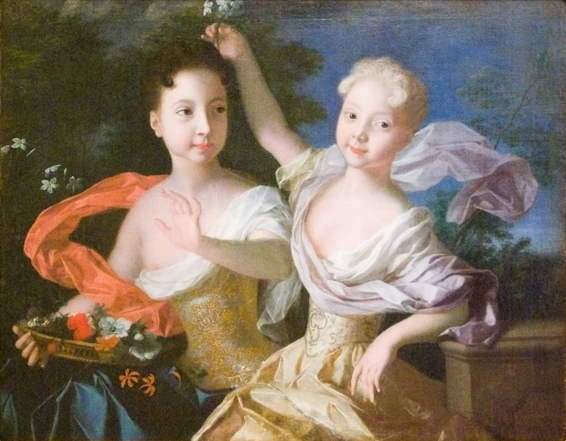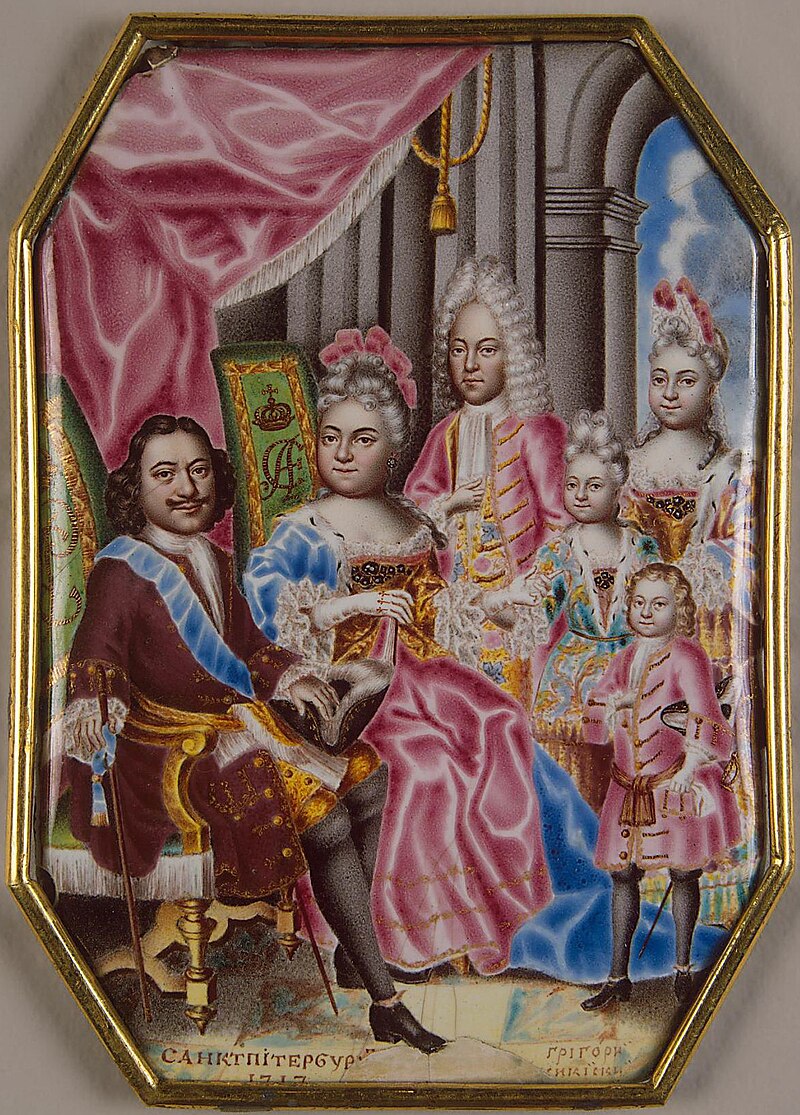by Susan Flantzer
© Unofficial Royalty 2018

Anna Petrovna of Russia, Duchess of Holstein-Gottorp; Credit – Wikipedia
Grand Duchess Anna Petrovna of Russia was one of three of the fourteen children of Peter I (the Great), Emperor of All Russia to survive childhood. Anna was the fourth of the twelve children of Peter the Great and his second wife, Catherine (Ekaterina) Alexeievna, born Marta Helena Skowrońska, the daughter of an ethnic Polish peasant, later Catherine I, Empress of All Russia. She was born in Moscow on February 7, 1708.

Peter the Great’s daughters Anna and Elizabeth; Credit – Wikipedia
Anna had eleven siblings, all of whom died in childhood except Elizabeth:
- Pyotr Petrovich born 1704, died in infancy
- Pavel Petrovich born 1705, died in infancy
- Catherine Petrovna (1706 – 1708)
- Elizabeth, Emperor of All Russia (1709 – 1762), unmarried
- Maria Petrovna of Russia (1713–1715)
- Margarita Petrovna (1714 – 1715)
- Pyotr Petrovich (1715 – 1719)
- Pavel Petrovich (born and died 1717)
- Grand Duchess Natalia Petrovna (1718 – 1725), died from measles a month after her father’s death
- Pyotr Petrovich (born and died 1723)
- Pavel Petrovich (born and died 1724)
Anna had two half-siblings from Peter the Great’s first marriage to Eudoxia Feodorovna Lopukhina:
- Alexei Petrovich, Tsarevich of Russia (1690 – 1718), married Charlotte Christine of Brunswick-Lüneburg, had two children: Grand Duchess Natalya Alexeievna and Peter II, Emperor of All Russia; both children died in their teens and Charlotte Christine died of childbirth complications a few days after the birth of her son
- Alexander Petrovich (1691 – 1692)

Peter I; Catherine I; Alexei, Tsarevich of Russia; Anna behind her sister Elizabeth and Peter Petrovich (1715 – 1719); Credit – Wikipedia
Although no official record exists, Anna’s parents, Peter the Great and Catherine, secretly married in St. Petersburg, Russia between October 23 and December 1, 1707. They married officially on February 19, 1712, at St. Isaac’s Cathedral in St. Petersburg. Their daughters Anna and Elizabeth were the bridal attendants and were legitimized on the same day as the wedding. Anna’s early years were spent at Kolomenskoye near Moscow. Her parents were mostly absent, so Anna and her younger sister Elizabeth were under the care of Russian and Finnish nannies. Later, Anna, Elizabeth, and their younger sister Natalia were placed in the household of Praskovia Feodorovna Saltykova, the widow of Ivan V, Tsar of All Russia (older half-brother of Peter I) and the mother of Anna I, Empress of All Russia. Peter the Great employed foreign tutors to teach his children but Anna and her two sisters remained highly uneducated, mainly learning foreign languages to prepare her for life at a foreign court.

Anna Petrovna, around 1716; Credit – Wikipedia
In 1721, Karl Friedrich, Duke of Holstein-Gottorp came to Russia hoping that Peter the Great would help him regain the territory of Schleswig from Denmark. Peter declined to help him but Karl Friedrich returned to his duchy with the hope that he would marry one of Peter’s daughters. In May 1724, Peter the Great agreed to the marriage of Anna and Karl Friedrich, and a marriage contract was signed in November 1724. The marriage contract stipulated that Anna could retain her Russian Orthodox religion and that any daughters would be raised as Russian Orthodox while any sons were to be raised in the Lutheran religion of their father. Anna and her husband renounced any claim to the Russian crown for themselves and their descendants. However, Peter the Great inserted a secret clause that reserved the right to proclaim a son from their marriage as the heir to the Russian throne. Peter had earlier proclaimed a succession decree stating that the reigning emperor could appoint a successor during his lifetime and that anyone may be named as his heir.
Peter the Great died two months after the marriage contract was signed without naming a successor. While Peter was dying, he asked to see Anna Petrovna to tell her his last wishes. By the time Anna arrived, Peter could no longer speak. Some historians speculate that Peter the Great wanted to declare Anne Petrovna as his heir. A coup arranged by Peter’s best friend Prince Alexander Menshikov proclaimed Peter the Great’s second wife (and Anna’s mother) Catherine the ruler of Russia. During the two-year reign of Catherine I, Empress of All Russia, the real power was held by Menshikov and members of the Supreme Privy Council.

Karl Friedrich, Duke of Holstein-Gottorp; Credit – Wikipedia
On May 21, 1725, Anna Petrovna and Karl Friedrich, Duke of Holstein-Gottorp were married in St. Petersburg. Both the wedding ceremony and the banquet afterward were extravagant affairs. Anna’s mother Catherine I, Empress of All Russia made her son-in-law Karl Friedrich a lieutenant colonel of the Preobrazhensky Regiment and gave him a place on the Supreme Privy Council, his own court, palace, and income. Anna and Karl Friedrich stayed in Russia for two years, until the death of Catherine I in 1727 changed their situation. Through the efforts of Prince Alexander Menshikov, Peter Alexeievich, the only son of Tsarevich Alexei Petrovich, Peter the Great’s deceased son from his first marriage, had been named by Catherine I as her heir. The 11-year-old boy reigned for three years as Peter II, Emperor of All Russia before he died from smallpox.

Anna Petrovna; Credit – Wikipedia
With a power shift to Menshikov and a quarrel between Karl Friedrich and Menshikov, Anna and her husband left Russia and went to Kiel, the capital of Karl Friedrich’s Duchy of Holstein-Gottorp. They arrived in Kiel in August 1727 and Anna was already pregnant with her first child. On February 21, 1728, at Kiel Castle in Kiel, then in the Duchy of Holstein-Gottorp, now in the German state of Schleswig-Holstein, Anna gave birth to a son named Karl Peter Ulrich. Sadly, Anna died three months later, on May 4, 1728, at the age of 20. Before her death, Anna expressed her desire to be buried at the Peter and Paul Cathedral in St. Petersburg. Anna’s coffin was taken by boat to St. Petersburg, where it was buried across from her parents’ tomb at the Peter and Paul Cathedral on November 23, 1728.
Anna’s son Karl Peter Ulrich succeeded her younger sister Elizabeth, Empress of All Russia as Peter III, Emperor of All Russia. However, the reign of Peter III lasted only six months. He was deposed by his wife, born Princess Sophie of Anhalt-Zerbst, who reigned as Catherine II (the Great), Empress of All Russia.

Tomb of Anna Petrovna; Photo Credit – Wikipedia
This article is the intellectual property of Unofficial Royalty and is NOT TO BE COPIED, EDITED, OR POSTED IN ANY FORM ON ANOTHER WEBSITE under any circumstances. It is permissible to use a link that directs to Unofficial Royalty.
Works Cited
- En.wikipedia.org. (2018). Grand Duchess Anna Petrovna of Russia. [online] Available at: https://en.wikipedia.org/wiki/Grand_Duchess_Anna_Petrovna_of_Russia [Accessed 18 Jan. 2018].
- Fr.wikipedia.org. (2018). Anna Petrovna de Russie. [online] Available at: https://fr.wikipedia.org/wiki/Anna_Petrovna_de_Russie [Accessed 18 Jan. 2018].
- Lincoln, W. Bruce. (1981). The Romanovs: Autocrats of All the Russias. New York, NY.: Doubleday
- Ru.wikipedia.org. (2018). Анна Петровна. [online] Available at: https://ru.wikipedia.org/wiki/%D0%90%D0%BD%D0%BD%D0%B0_%D0%9F%D0%B5%D1%82%D1%80%D0%BE%D0%B2%D0%BD%D0%B0 [Accessed 18 Jan. 2018].
